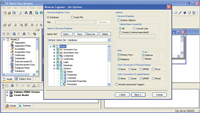Product Reviews
Designing Databases with ERwin Data Modeler 7.3
This complete package takes care of modeling data and managing the resulting designs -- provided you're using entity-relationship modeling to design your databases.
This month we're looking at two related tools for data modeling: CA ERwin Data Modeler for designing your database schema and Red Gate SQL Source Control for keeping track of the changes that you make to your schema as you add and modify applications. It's easy to see why ERwin earned Merit Award distinction in the Databases and Data Development and Modeling category of this year's VSM Readers Choice Awards. The tool may be expensive, but it's hard to think of anything ERwin doesn't do in the data-modeling field.
ERwin lets you graphically develop a logical data model and generate a database schema from your design, which you can implement in your relational database management system. ERwin likely supports your relational database engine -- the latest version adds support for Teradata, for instance. The ERwin design interface makes it easy to lay out and refine your initial designs. But only two notations are supported: IDEF1X and Information Engineering.
You can also reverse engineer existing databases to create a data model. ERwin goes beyond data structures to include modeling triggers and stored procedures. As you make changes in development, ERwin can generate alter scripts that will upgrade your production database to match the changes you've made in your dev database.
ERwin also understands the difference between operational databases and data warehouses. It includes tools that support linking several operational databases to create a single data warehouse, and for modeling the fact tables that support end-user reporting. Unfortunately, ERwin uses two separate modeling tools for operational databases and warehouses. You can convert operational models to warehouses, but the conversion only handles the differences between the modeling tools and doesn't add support for data warehousing -- that's up to you. ERwin supports simple volumetric analysis so you can estimate database size and forecast hardware requirements.
ERwin will import and export models from a huge number of formats and repositories, including UML, XML and the Common Warehouse MetaModel. Integration with Visual Studio is lacking, though ERwin does integrate with Visual Studio Team System 2008 Database Edition.
With large data models, the ERwin reporting tools let you produce summaries of key information. ERwin comes with Crystal Reports, but will probably work with your existing reporting tools via an OBDC read-only driver. You can output results in a variety of formats.

[Click on image for larger view.] |
| When reverse engineering an existing database, ERwin not only provides a long list of objects it will model, but also infers relationships not explicitly defined in the database. |
There are two caveats. First, the "ER" in ERwin stands for entity-relationship modeling. If you're looking to generate a database from your class design, ERwin probably isn't the tool you want -- look for a UML-based tool. ERwin has data modeling, rather than object modeling, at its core.
The other caveat is price. At $4,800, you'll have to ask yourself if you need all the tools that ERwin provides. If you're not planning on building a data warehouse, ERwin support in that area won't have much value for you. There are some free data-modeling tools available (including a community edition of ERwin Data Modeler) and standalone tools that provide functionality that the free tools are missing. Red Gate SQL Compare, for instance, costs less than $400 and will allow you to compare two databases and generate an alter script. Putting together a collection of tools won't give you the integration that ERwin provides, but it will let you pick just the ones you need.
ERwin Data Modeler
CA Inc.
Web: erwin.com
Phone: 800-225-5224
Price: $4,795
Quick Facts: A comprehensive tool for data modeling and managing database designs
Pros: Provides end-to-end support in one package for both operational databases and data warehouses
Cons: Expensive; may be more tool than you need
About the Author
Peter Vogel is a system architect and principal in PH&V Information Services. PH&V provides full-stack consulting from UX design through object modeling to database design. Peter tweets about his VSM columns with the hashtag #vogelarticles. His blog posts on user experience design can be found at http://blog.learningtree.com/tag/ui/.